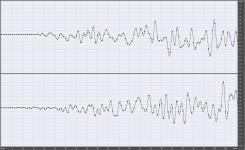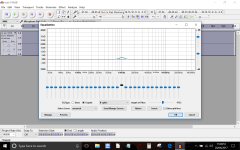I keep listening  (nah, its really a
(nah, its really a  as its all interesting and fun) and have just sent Pavel my notes so far.
as its all interesting and fun) and have just sent Pavel my notes so far.
Scott has a point you know:
What is odd is that I have deliberately tried stuff like 4558's in such things as CD players and the like, just for fun, just to see, as you do, and I am pretty sure with my opinion that they are subjectively inferior to the 5532's and similar.
I suspect my replay chain isn't as good as it could be because the only means I have of playing these directly is via either of my two laptops. I can convert the files to 44.1/16 and play them via my Marantz SA-CD DAC on a USB stick but then I can't switch between various tracks and parts of tracks quickly.
All good fun though.
Scott has a point you know:
A lot of work to prove the 741 really isn't audio nirvana.
What is odd is that I have deliberately tried stuff like 4558's in such things as CD players and the like, just for fun, just to see, as you do, and I am pretty sure with my opinion that they are subjectively inferior to the 5532's and similar.
I suspect my replay chain isn't as good as it could be because the only means I have of playing these directly is via either of my two laptops. I can convert the files to 44.1/16 and play them via my Marantz SA-CD DAC on a USB stick but then I can't switch between various tracks and parts of tracks quickly.
All good fun though.
I keep listening(nah, its really a
as its all interesting and fun) and have just sent Pavel my notes so far.
Yeah, thank you! I did read it, and I agree its all interesting and fun
A lot of work to prove the 741 really isn't audio nirvana.
Maybe if JC used it instead of that AD712 he would get all AAA ratings from RH
Spices, salt and pepper seem to be requested ingredients in audio
I would like to add that cheating based on file data is IMO impossible in this test. I am posting the direct difference between samples at the beginning of the "best" and "worst" files, when the signal starts from "silence". One can see that the difference between the files is sub-LSB. The Y axis in the plot is in 16-bit LSB. So everything below value "1" is higher resolution of 24-bit data. There is, of course, some small time difference between the files, in microseconds, that results in amplitude differences of samples with higher amplitude. This would be minimized by diffmaker method, but I am showing direct subtraction now. One can see that remaining "difference" in noise is in any case inaudible.
Attachments
Human brains can sometimes detect signals below a noise floor. I don't know exactly how far below, but there is a story Bob Katz tells in which he describes hearing a -140dB tone somewhere down below the noise floor in that case. I don't know details of the story other than he said his room is very quiet.
Last edited:
Human brains can sometimes detect signals below a noise floor. I don't know exactly how far below, but there is a story Bob Katz tells in which he describes hearing a -140dB tone somewhere down below the noise floor in that case. I don't know details of the story other than he said his room is very quiet.
Yes, human brains can detect signals below noise floor, but 10 - 20dB below noise floor would be a limit.
This -140dB audiophile story is definitely exaggerated. I can also hear -120dB from Philips test SACD disc. But -120dB re what?? Only in case that I turn volume full right. But it would not be possible to listen to the music at such high volume/gain. Look, let's say you/me listen at maximum of 110dB SPL. Hearing threshold would be 0dB SPL when surrounding is absolutely quiet. So it would be absolutely impossible to hear -140dB tone, which would make -30dB SPL. Utter nonsense, one of the many audiophile nonsenses.
Mark, I can generate very low level tone for you.
Nothing directly (on laptop) but I can extract a clean sounding 1kHz tone from it and make that very audible.
Yes, after manipulation with the file (digital amplification). How about the second file (-100dB), I recently edited my post and added it.
we have the same op amps in this test as we had in the previous test,
but now we have 5 files ...... Interesting, isn't it?
One file is the input?
Mark, I can generate very low level tone for you.
I'm sure there is a mistake in the context of this claim. Re: 1 Pa would be absurd.
Yes, after manipulation with the file (digital amplification). How about the second file (-100dB), I recently edited my post and added it.
Not reliably. I almost think I can when using my headphone amp but it is tenuous, and if I do this (image) then I can say 100% yes.
Attachments
Can't hear either one on my laptop. I will try later on my main system.
On your system, with DAC and amplifier, you should (must) hear at least the -100dB tone at maximum volume. In case you have really low noise system and high gain, you will hear even the -120dB tone.
But, this has nothing to do with usable dynamics during normal listening. That's why I posted the two low level tones. I hope Bob Katz did not want to say he heard generated -140dB tone re anything. Don't you have a link to his claim? He seemed to me to be pretty wise and experienced guy.
from reading the codec lit and talking to Monty of Obb Vorbis fame I think this is the case:
there could be a lesson from perceptual lossy compression codecs at 320k - where the latest codecs are "transparent" - even to the developers who train on the artifacts - for virtually all "music"
they only use ~ 7 bits per critical band to encode levels - ~ 1% frequency content relative accuracy seems to get us a long, long way in audio perception - as long as we can log range
@jcx
Well, from good records -usually classical or jazz- I can differentiate Ogg -q9 (320 kbps) from FLAC in my second system (with PC). With the current commercial music, so badly recorded and with so little dynamic range, I can not.
With Ogg -q10 (500 kbps) is a lottery, I would never pass an ABX test.
Well, from good records -usually classical or jazz- I can differentiate Ogg -q9 (320 kbps) from FLAC in my second system (with PC). With the current commercial music, so badly recorded and with so little dynamic range, I can not.
With Ogg -q10 (500 kbps) is a lottery, I would never pass an ABX test.
from reading the codec lit and talking to Monty of Obb Vorbis fame I think this is the case:
John, I did an experiment years ago while thinking about making a synthesized 60Hz. power supply for a TT but never proceeded. I took 60Hz exactly and encoded it to MP3 at the worst resolution (IIRC 64K). I then I took 60Hz plus one cycle in a minute. When plotted the results were perfect exact zero crossing of both at sample no. 2,646,000. I asked Bob Adams but he shrugged that it made sense but he didn't know enough about MP3 details.
@jcx
Well, from good records -usually classical or jazz- I can differentiate Ogg -q9 (320 kbps) from FLAC in my second system (with PC). With the current commercial music, so badly recorded and with so little dynamic range, I can not.
With Ogg -q10 (500 kbps) is a lottery, I would never pass an ABX test.
IME 320kbps mp3 is just at the limit of distinguishability, depending on recording quality, as you have mentioned. Did some tests on this as well, 96/24 x 320kbps mp3. Well recorded classical with big differences between ppp and fff was distinguishable, at high concentration. Typical nowadays commercial production was not. 256 kbps mp3 is enough for most commercial pop production, which is horrible, but it is a fact.
What happens if you try this with the -120 dB tone?Not reliably. I almost think I can when using my headphone amp but it is tenuous, and if I do this (image) then I can say 100% yes.
I think I may have said before that adding a little distortion at a single stage in the audio path may sound better...
Factor in even-harmonic cancellation between stages and it might also measure better. Complexity increase achieved.
- Status
- This old topic is closed. If you want to reopen this topic, contact a moderator using the "Report Post" button.
- Home
- General Interest
- Everything Else
- Hires 96/24 listening test of opamps

